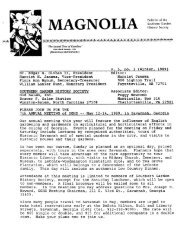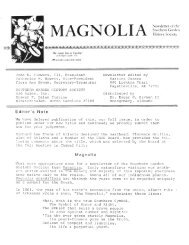Magnolia Newsletter Fall 04 - Southern Garden History Society
Magnolia Newsletter Fall 04 - Southern Garden History Society
Magnolia Newsletter Fall 04 - Southern Garden History Society
You also want an ePaper? Increase the reach of your titles
YUMPU automatically turns print PDFs into web optimized ePapers that Google loves.
Book Review<br />
No One <strong>Garden</strong>s Alone: A Life of Elizabeth Lawrence, by<br />
Emily Herring Wilson. Beacon Press, Boston, 20<strong>04</strong>.<br />
Hardcover, 334 pages, ISBN: 0-8070-8560-0-X<br />
The centennial of Elizabeth Lawrence’s birth in 19<strong>04</strong> has<br />
been marked by two important events: the publication of No<br />
One <strong>Garden</strong>s Alone: A Life of Elizabeth Lawrence, and the<br />
organization of The Friends of Elizabeth Lawrence, whose<br />
purpose is to assure the preservation of her house and garden<br />
in Charlotte, North Carolina. Each of these efforts has been<br />
in process for some time, and their coincidence this year<br />
underscores an increasingly broad appreciation of her place in<br />
<strong>Southern</strong>—and American—garden history. She, like her longtime<br />
friend Eudora<br />
Welty, was indeed<br />
“one of our own,”<br />
but her writings<br />
reached a wide<br />
appreciative<br />
audience outside the<br />
“Middle South,”<br />
across the country,<br />
and beyond the sea<br />
in England.<br />
I first came to<br />
know Elizabeth<br />
Lawrence long after<br />
she and her A<br />
<strong>Southern</strong> <strong>Garden</strong><br />
had gained fame.<br />
Both were nearing<br />
Elizabeth Lawrence beckoned to readers of her<br />
first garden column, published in the Charlotte<br />
Observer on August 11, 1957. (Courtesy of the<br />
Charlotte Observer.)<br />
their twilight. It was<br />
in early autumn, in<br />
the mid 1970s, when<br />
I accompanied a<br />
friend to a drinks<br />
party in the garden of<br />
the late Baker Wynne, a Raleigh friend of Miss Lawrence’s.<br />
His Williamsburg-style brick cottage stood at 1411 Jackson<br />
Street, about a block’s distance from the Lawrence house at<br />
115 Park Avenue. Bay, my friend, lived on Park Avenue, a few<br />
doors from Elizabeth Lawrence’s house. She was a student in<br />
the department of landscape architecture at North Carolina<br />
State University where Elizabeth Lawrence was the first female<br />
student. The friendship of the two gardeners was discussed<br />
and, so too, was their friendship with Isabelle Bowen<br />
Henderson. Her Colonial Revival house and garden were<br />
located a few blocks to the northwest, along Oberlin Road,<br />
and included an herb house. The Lawrence, Wynne, and<br />
Henderson gardens were important efforts at place-making in<br />
Raleigh and North Carolina. Today only the Henderson<br />
house and garden survive. The Park Avenue house that<br />
Elizabeth Lawrence’s family owned in Raleigh from 1918 into<br />
1948 was destroyed this year. Its garden had vanished years<br />
ago.<br />
This Elizabeth Lawrence renaissance can be traced to the<br />
posthumous publication of <strong>Garden</strong>ing for Love in 1987, A<br />
Rock <strong>Garden</strong> for the South and Through the <strong>Garden</strong> Gate in<br />
1990, and the re-issue of A <strong>Southern</strong> <strong>Garden</strong> in 1991, with a<br />
new forward by Edith R. Eddleman. Miss Eddleman, one of a<br />
new generation of Lawrence admirers, collaborated with<br />
Doug Ruhren in the designing and planting of the Elizabeth<br />
Lawrence border at the North Carolina State Arboretum. It<br />
was kindled anew with the publication of Two <strong>Garden</strong>ers: A<br />
Friendship in Letters in 2002. In March 1958, The New Yorker<br />
had published the first of Katharine S. White’s columns,<br />
“Onward and Upward in the <strong>Garden</strong>.” Within months<br />
Elizabeth Lawrence wrote a warmly appreciative letter, which<br />
prompted a correspondence between the two gifted writergardeners<br />
that continued up to White’s death in 1977. Emily<br />
Herring Wilson edited the group of about 150 letters for Two<br />
<strong>Garden</strong>ers, which engaged thousands of readers. Soon into its<br />
pages one saw that Elizabeth Lawrence was in no way “playing<br />
second fiddle” to the better known wife of E. B. White. This<br />
was letter-writing between equals at least, if the balance did<br />
not actually shift in Elizabeth’s favor. It has come to be<br />
acknowledged as one of the most engrossing American garden<br />
correspondences of the twentieth century.<br />
Now, two years later, Beacon Press has published Emily<br />
Herring Wilson’s biography of Miss Lawrence. The facts of<br />
Elizabeth Lewis Lawrence’s life reflect the nurturing of strong<br />
female relatives and friends and that of a wider circle of<br />
gardening friends, including a cast of sympathetic bachelors,<br />
who shared her interest in literature. The daughter of Samuel<br />
Lawrence (1874-1936) and Elizabeth “Bessie” Bradenbaugh<br />
(1876-1964), she was born in Marietta, Georgia, on 27 May<br />
19<strong>04</strong> at the home of her Lawrence grandparents. Childhood<br />
visits with these grandparents in Marietta and others with her<br />
maternal grandmother Ann “Nannie” Beard (Neal)<br />
Bradenbaugh (1856-1933) in Parkersburg, West Virginia,<br />
shaped a love of family that sustained her through life. The<br />
young Lawrence family first settled in Hamlet, North<br />
Carolina, where Mr. Lawrence was engaged in a railroadrelated<br />
sand and gravel business. After periods in Richmond,<br />
Virginia, and Garysburg, North Carolina, where her father<br />
organized the Lawrence Sand and Gravel Company, Elizabeth<br />
and her family (and the company offices) moved to Raleigh.<br />
There, in 1918, they acquired the house at 115 Park Avenue,<br />
a short half-block off the capital’s prominent Hillsborough<br />
Street, which would be their home for thirty years.<br />
Elizabeth Lawrence enrolled at St. Mary’s School<br />
where she graduated in 1922. Through the influence of Grace<br />
St. John, a St. Mary’s teacher and mentor, she applied to<br />
Barnard College in New York City, was accepted, and<br />
graduated from the woman’s college of Columbia University<br />
in 1926. Returning to Raleigh and living again at home, she<br />
applied to North Carolina State College of Agriculture and<br />
Engineering (today’s North Carolina State University), took<br />
courses over a period of years, and received a Bachelor of<br />
Science degree in landscape architecture in 1932.<br />
A career of nearly fifty years as a designer,<br />
plantswoman, journalist, and garden writer began in 1932<br />
with her association with Isabel Bronson Busbee, an older<br />
neighbor in nearby Cameron Park, who had a small landscape<br />
Vol. XIX, No. 3 <strong>Magnolia</strong> • <strong>Fall</strong> 20<strong>04</strong> 13
















